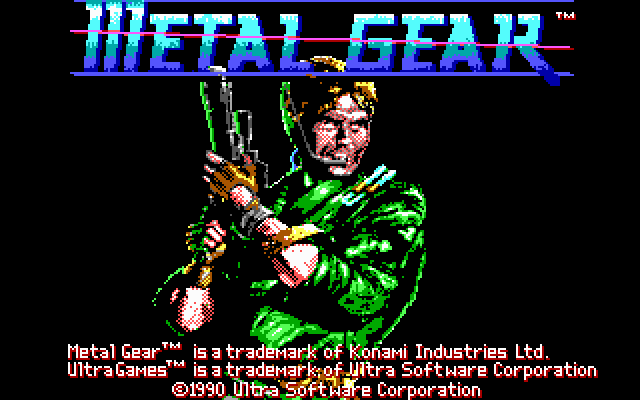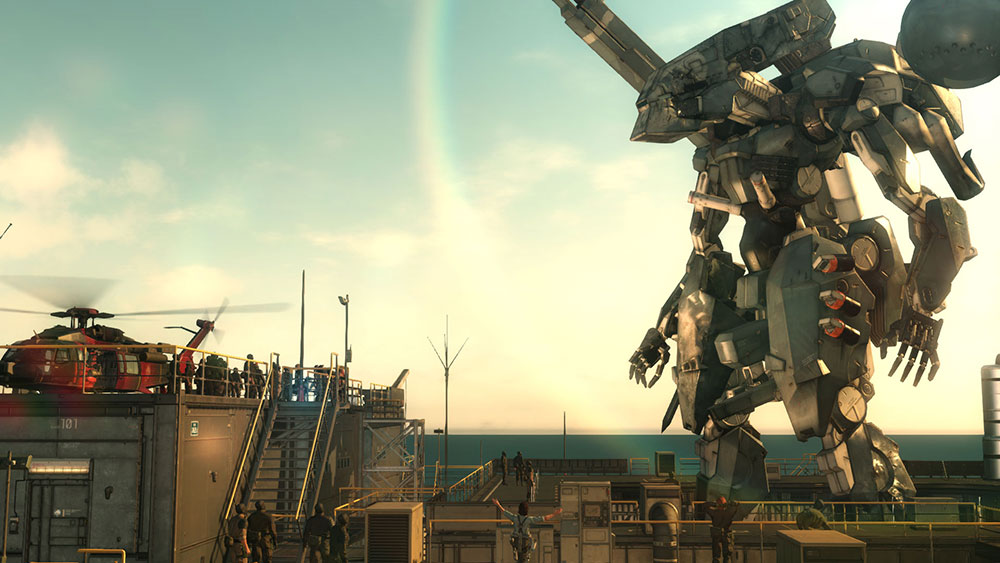Guest Post: Metal Gear Solid – A Retrospective PART 2
This retrospective has kindly been written by Shaun Sannerude, aka @rudecold
Metal Gear Solid 5 – Is Kojima’s final Metal Gear game his best yet? Part 2: My Phantom Pain
The second part of the two part retrospective opinion piece contains massive spoilers for Metal Gear Solid 5 as well as spoilers for Metal Gear and Metal Gear 2: Solid Snake. This does not include non-canon games such as Ghost Babel or the spin off game, Metal Gear Rising: Revengeance.
Now before moving onto MGSV we have to rewind before the events of MGS to where the Metal Gear series began with the first two games being released for the MSX2 way back in 1987 and 1990 – Metal Gear and Metal Gear 2: Solid Snake. Metal Gear is set in 1995 and introduces Solid Snake as a rookie member of the FOXHOUND unit created by Big Boss. He is on his first mission to infiltrate Outer Heaven to find out what happened to his team mate and fellow agent Gray Fox, who is believed to have been captured. In the end, you learn that Big Boss is in fact the mercenary leader of Outer Heaven and is using his connections to steal military intelligence and create his own military force to become the world’s greatest superpower – evil stuff indeed! Of course Snake defeats him and the sequel, which is set 4 years later in 1999 has Snake brought out of retirement on a mission to rescue an important scientist. Snake again infiltrates a remote base only to find that Gray Fox has defected and the group he is working for is led none other than by Big Boss! (cue the ‘dun dun duuuuuuun’ music). Big Boss had somehow survived, only to be defeated yet again. I can’t really add much more about the games as I have only played Metal Gear very briefly and Solid Snake not at all, but they are both classic 8-bit action/adventure/stealth games and therefore play very differently to their series counterparts.

In the Metal Gear series timeline, there is a twenty-year gap between Peace Walker and Metal Gear. When rumours started circulating that a new Metal Gear game was coming it seemed obvious that it would be set between this time period and that Big Boss would be the protagonist. Questions were raised as to whether we would get the missing piece of the history that links Big Boss with becoming the leader of Outer Heaven, especially as it was likely at the time and later confirmed that it would be Kojima’s final Metal Gear game. At the end of Peace Walker Big Boss is all about destroying nuclear threats so what happened in those 20 years to make him want to become the world’s greatest superpower instead? Fans of the series would say there was a definite need for another game in the series to fill in the blanks but did MGSV deliver on this?
MGSV was released in two parts that form a complete package. The first part called Ground Zeroes was pretty much an extended demo that acts as a prologue with the setting taking place in just a single location. It was incredibly short but gave you a taster to how the gameplay and combat had evolved and also helped whet the appetite for the rest of MGSV, called The Phantom Pain (TPP).
Ground Zeroes is set in 1975 a few months after the events of Peace Walker. Big Boss is tasked with infiltrating an old refugee camp to attempt to rescue Paz Ortega Andrade (a young agent and spy that double crossed Big Boss in Peace Walker) and Ricardo “Chico” Valenciano Libre (a young former child soldier who aids Big Boss in Peace Walker). Chico was captured by the games main antagonist, Skull Face (commander of the paramilitary force, XOF), while trying to rescue Paz. The story, though brief, has a darker tone than previous instalments and ends with Big Boss rescuing both Chico and Paz and while travelling to return to Mother Base he has to remove a bomb surgically implanted into Paz. Once at Mother Base Big Boss finds it under attack from XOF forces who have ambushed the base under the guise of a UN inspection for nuclear weapons. They escape the base, which is collapsing in the sea, only to find out there is a second bomb in Paz. Knowing she is about to die, she sacrifices herself by jumping from the helicopter but the resulting explosion causes the helicopter to spiral out of control and crash into a pursing XOF helicopter. It sets the scene nicely for TPP which I will get to shortly.
Kojima with the Metal Gear series always visually pushes the boundaries and this continues with Ground Zeros. It is utterly gorgeous and almost photo realistic. When my wife first saw the game, she thought I was watching a movie, it’s that impressive. The game also introduces Keifer Sutherland as the voice of Big Boss rather than David Hayter who had voiced Solid Snake and Big Boss in all the previous instalments. This wasn’t well received by fans, which was to be expected. Sutherland actually doesn’t have that many lines in Ground Zeros but you still can’t help but miss Big Boss’s usual gravelly voice.

Gameplay in Ground Zeros is drastically revamped. No longer does Big Boss have to find rations for health as it now automatically regenerates over time. Another new feature is the ability to mark enemies using the games binoculars so that they are always displayed on the map. The alert system has been tweaked to not show the different alerts on screen but rather through visual and audio representations and also included is the new ‘Reflex Mode’ where if you are spotted by the enemy, time slows down allowing you to take out the enemy before they can sound the alarm. These changes breathe new life in the series and make the game feel much more modern.
TTP adds further gameplay enhancements and introduces the buddy system. For the first time in the series you can be aided in battles by an ally. Each ally has a very different skill set. Initially, you begin with a horse which helps your journey across the vast Afghan wilderness at a much greater speed. It offers very little else apart from creating the most realistic horse crapping animation witnessed in a game! As you progress in the game you stumble across an absolutely adorable orphaned wolf pup. Big Boss takes him in, calls him D-Dog and the relationship builds through some cute cut scenes when you return to base. Cleverly, D-Dog grows up as the game progresses and becomes a brilliant companion who can join you in the field, sniffing out enemies and useful items and helps take down the enemies too. The buddy system can’t be faulted, it works so incredibly well, and is instrumental with the game being the first in the series to be open-world.

TTP being open-world changes the feel and structure of the series, both positively and negatively. On the positive note, the gameplay is incredibly fun and addictive. There is so much freedom to tackle missions in a variety of different ways as you have such a huge arsenal of weapons and can infiltrate bases and army camps both during the day or night and from many separate entry points. You can even call on air support to take out tanks or gas enemies to sleep. The open-world format unfortunately means that apart from the opening prologue there is very little of the game taking place in an indoor setting. I feel this is a massive missed opportunity as the prologue worked brilliantly because of the tension it created with having narrow rooms and corridors to sneak through to avoid the enemies. It was classic MGS style and it would have been great to have more situations like this throughout the game.
The biggest negative for me with the open-world format is that the story takes a huge hit. Like Peace Walker the storyline progresses through missions rather than one seamlessly connected sequence of events. This worked fine for Peace Walker because as a handheld game it was made to be played in smaller chunks, however, crucially for TTP it hurts the flow of the story and it pains me to say that it has the weakest story of the entire series. TTP’s story does start off strong as it reeks of Kojima’s creativity and Metal Gear craziness. The prologue starts in a hospital ward and you soon learn that after the events of Ground Zeros Big Boss is in a bad shape having awoken from a nine-year coma to find that he has had his left arm amputated and foreign objects embedded into his body, including one giving him a pronounced ‘horn’ just above his already blinded right eye.
Big Boss has to escape the hospital after a failed assassination attempt on him by Quiet, an agent that you meet again later on in the game. He is helped by a mysterious man with a bandaged face called Ishmael. While trying to escape it all gets a little crazy with soldiers killing hospital patients and doctors while on the search for Big Boss, it’s all very bloody and brutal. As if that wasn’t enough, Big Boss is confronted by the Man on Fire – as literal as it sounds, a guy covered in flames who can manipulate fire. You have no idea who this strange guy is at the time and it’s like something out of a horror film with Big Boss being hunted down in the small confines of the hospital. It’s all played out brilliantly as Big Boss starts by having no use in his legs after being in a coma for years, crawling along the corridors, before eventually regaining control and the prologue finishes with a typical ‘Hollywood’ vehicle chase scene before Big Boss is rescued and whisked away in a helicopter by Revolver Ocelot who is now working for a new mercenary organisation called Diamond Dogs, founded by Kazuhira “Kaz” Miller (Big Boss’s second in command in Peace Walker) as a replacement for Militaires Sans Frontières.

From this point the game takes on the mission structure with Big Boss (now with a funky red prosthetic arm) having to rescue Kaz and find out more about who destroyed their base 9 years previously, while also expanding Diamond Dogs as a faction. Skull Face continues to be the main antagonist after Ground Zeros who surprise surprise has his own Metal Gear called Sahelanthropus and plans to use a parasite that kills anyone who speaks English. Skull Face doesn’t develop into a very interesting villain and is literally killed off where you think the game is going to come to an end, however, missions and the story still continue which unfortunately fuels the inconsistency to the overall storyline.
I only found one character of any interest in the game and that was Quiet. Don’t let her practically nude attire distract from the fact she has a really deep story arc which explains why she wears so little clothing. Quiet doesn’t speak, hence her name, as she has been infected with the parasite that kills English speaking people. Quite early on in the game she is captured by Big Boss and later becomes a very worthwhile ally. Having Quiet as part of the team causes a lot of friction between Kaz and Big Boss. Kaz doesn’t trust her motives and in a way, it is right to do so, as you learn that she has been tasked to infiltrate Diamond Dogs to spread the parasite. Thankfully, she ends up siding with Big Boss and develops quite a sweet relationship with him and her ending is touching as she is forced to have to finally speak to contact a helicopter to retrieve a severely poisoned Big Boss. Quiet then has to disappear into isolation as to not cause an epidemic, leaving her fate unknown. It’s also quite cool within the story that you get to meet a twelve- year old version of Liquid Snake, known as Eli who is head of some child soldiers. Unfortunately, you don’t learn much about the whole Big Boss cloning project and you don’t get to meet a young version of Solid Snake either which is another missed opportunity.
As previously stated, once Skull Face is killed the game still continues. This is where the game majorly falters. You get a mix of missions that progress the weak story which now focuses on the distrust of Quiet and Eli getting his hands on Sahelanthropus, while having to play repeats of previous missions with harder settings or basic equipment. These missions really tedious and were not needed and only act as filler to an already quite sizeable game. The final story mission is a repeat of the prologue with slight story adaptations to shape the huge plot twist, that for the entire game you weren’t actually playing as Big Boss! There are subtitle hints along the way so it didn’t come as much of a surprise, but for me it was a disappointing twist that I didn’t really want to believe. You learn that Big Boss was in fact Ishmael who helped you escape the hospital and that you were a medic in the same helicopter crash at the end of Ground Zeros. You were given plastic surgery and hypnosis to become a second “phantom” Big Boss to act as a decoy for his enemies while the real Big Boss wages a covert war on the series overarching evil organisation called Cipher (which XOF were part of) and later becomes The Patriots (it’s all very overly convoluted). This really grinds on me as Big Boss is meant to be a legendary solider and yet a medic can be hypnotised to be as good a soldier as he is. It completely ruins his legendary status. The only thing that works well with this twist is that you learn that it was in fact the ‘phantom’ Big Boss that Solid Snake faces and kills in Metal Gear while the real one resurfaces for Solid Snake.

My final gripe with the story is the fact that it doesn’t fully wrap up Eli’s story arc. The last you see of him he escapes Mother Base with Sahelanthropus. What’s more infuriating is that after the games release it was stated in the media that there was meant to be a final mission with Big Boss confronting Eli. Storyboards, some animation and cut scenes were created for this mission but it never made an appearance in the game. Why? I can only guess it was because of Kojima and Konami’s fallout and the further costs and lack of time to fit it in. It’s sad to learn that gamers haven’t got to play TTP in its entirety and I’m surprised that this final mission wasn’t released as part of the MGSV: The Definitive Edition with Ground Zeros and TTP together as one complete package.
Story aside, another disappointment I have with the game is with the boss battles. Unlike previous instalments, the battles were uncreative therefore making them very forgettable and there also wasn’t that many of them either. When you fight the Man on Fire there are multiple ways of defeating him but it is all too easy and over quickly. There is a typical sniper fight with Quiet which doesn’t have the same impact as it should because you have seen it all before. The main battle against The Skulls was highly annoying and the best method is to just run from them, climb on to a roof and boringly pick them off from there. Even the fight with Sahelanthropus was similar to previous battles against Metal Gear mecha units but at least it had a bit of variety, making it the boss battle I enjoyed the most.

In answer to whether TTP is Kojima’s finest Metal Gear game, the simple and unfortunate answer is that it is clearly not. Kojima achieves his aspiration of creating an open-world Metal Gear and in doing so it plays extremely well with great diversity but it ultimately falls short with an unfinished, somewhat rushed and disappointing story. Maybe my expectations were too high for TTP but it was to be expected due to previous instalments in the series delivering so highly. If the gameplay wasn’t so enjoyable I really think I would have struggled to have completed the game. I can’t help shake the feeling that it was a huge missed opportunity in giving the fans a true Big Boss story that linked nicely onto Metal Gear. There is still, however, a gap in the timeline that can be filled but without Kojima at the helm I would be surprised to see a new game in the series that centred on Big Boss or Solid Snake.
I’m left not knowing if I actually want a new ‘true’ Metal Gear game but instead, maybe it’s the perfect time for a remake of Metal Gear and Solid Snake for current generation consoles. Konami obviously still want to release games set in the Metal Gear universe with them releasing Metal Gear: Survive next year. This zombiesque alternative reality spin off doesn’t really appeal to me. I am interested to know what the future is for one of gaming most iconic series and I do hope Survive is a success so the series isn’t tarnished. I just feel that a core Metal Gear game without Kojima might lose everything that made Metal Gear such a special and unique series to me.

